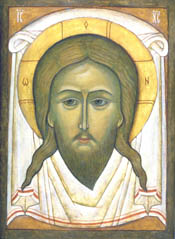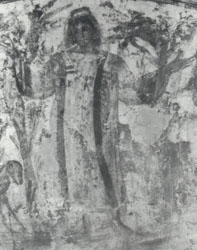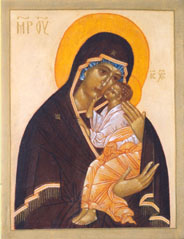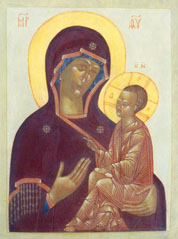|
home page |
background |
contact |
copyright |
theology of icons |
history of icons | icons a | icons b | icons c | icons d |
|
History of The Icon
|
 |
Icon is a Greek word meaning image. The very first icon can be said to have been made by Christ himself, as an imprint of his face on cloth was sent to Edessa at the plea of King Abgar, to cure him from leprosy. King Abgar was healed by the touch of the cloth and it was kept, with much veneration, in the city. This image has been painted in an icon called ‘The Holy Face’ which is still very much loved and used.
Other early types of icons that still remain are found in the Roman catacombs, where they were painted onto the walls. Here Christ was often depicted as the lamb, symbolising 'The Good Shepherd'.
Images from mythology were frequently used to incorporate the Christian message and sometimes, for instance, Hermes can be seen carrying a lamb on his shoulder. An early image of Christ can also be seen, going heavenwards in a quadriga, haloed by the rays of the sun, representing the Ascension of Christ.
Images of The Mother of God were painted, in the type called 'the Orante' (or Praying One). Here she stands in prayer with her hands stretched up, interceding. She is dressed veiled, in the traditional style of the time and as we still know her.
|
|
The Holy Face |
|
Old Testament scenes were also depicted in the catacombs, such as the sacrificial offering of Isaac by Abraham, the bronze serpent held up in the desert, and Jonah being swallowed by the whale. These scenes each prefigured Christ's Crucifixion and Resurrection in some way, encouraging the Christians in time of martyrdom. Feast scenes developed slowly over a period of time and can be seen in early illuminations, where the details evolved.
The first icons, made on wood, were painted in a technique called 'encaustic'. Pigment was either mixed with hot wax or else with cold wax and oil or egg. Encaustic was generally used in the ancient world for painting on wood but it was very complicated to apply. From the eighth century icons were painted in egg tempura. Almost the only remaining early icons exist at Saint Catherine’s Monastery in Sinai, because iconoclasm did not reach there.
The theology of the icon was worked out, especially, during a time of great suffering in the Orthodox Church, when between (approximately) 720-787 AD and also 815-843AD a huge and violent controversy erupted, brought about by a group of iconoclasts. At this time many Christians were tortured and martyred for their use of images. A huge proportion of the early icons were destroyed in the struggle. |
 |
|
The Mother Of God Orante. Catacombs of Main Cemetery, Rome |
|
 |
Saint John of Damascus and Saint Theodore the Studite both wrote treatises in response, showing that the icon was not an idol but a witness to sanctity and a vehicle for prayer, that it should be venerated but not adored. They explained theologically the difference between the Old Testament and the New Testament which had heralded God Incarnate. They defended the icon, saying that because Christ appeared in the flesh he could be depicted in icons, but that God the Father should not be represented as he is Spirit and therefore unseen.
Many icons are vehicles of miracles, with healing powers. Some are given special properties that draw people to them, such as exuding fragrant myrrh . Icons have become so deeply respected and venerated that Christians, and even some people from other faiths, are drawn to pray before them for God's intervention and help.
The Mother of God has a very important place in iconography. Saint Luke painted the very first icon of her during her lifetime. She is always portrayed with three little crosses or stars on her mantle to depict her virginity. Her outer mantle of wine-brown shows her humanity and her inner garment of blue reminds us of her holiness.
At the Council of Ephesus in the third century she was proclaimed to be truly The Mother of God and Ever Virgin Mary. After this her icon developed rapidly. There are very many variations of her icon which come from four different basic types . The oldest of these is 'The Mother of God of The Sign' (similar to The Orante, but including an image of the Infant Christ) . Next there developed a more commanding icon called 'The Hodegetria Mother of God' (or The One Who Shows the Way). After this a very gentle type of icon emerged known as 'The Mother of God of Tenderness'. The last type of icon to develop was 'The Mother of God Enthroned'. |
|
The Mother of God Of Tenderness |
|
The Mother of God is always depicted with Christ, guiding us to him and praying for us in her very special role as intercessor. In the history of the Orthodox Church her icons have been carried in procession through besieged towns, saving them miraculously from their enemies. They have been preserved, copied and loved because of the great help that she gives.
People travel from afar to pray before her icon for succour and consolation. Today, in modern times the icon is still an object of great veneration. Many people are drawn by its mysterious beauty, by the peace and stillness that radiate from within. One feels a timeless quality, an encounter with another world. Through the media, the icon has become widely celebrated, creating the possibility for more people to discover it, who are searching for a spiritual encounter in this modern age.
|
 |
| |
|
|
The Tichvine Mother Of God |
|